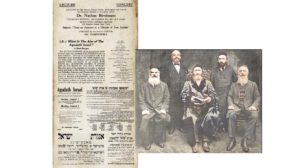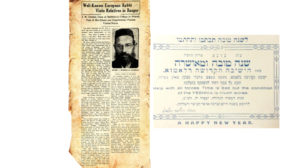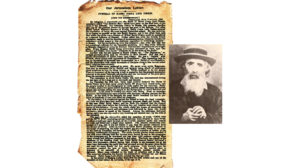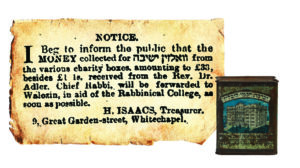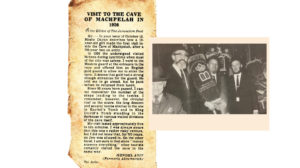The Woman Who Unearthed Jerusalem

Armed with shovels, grit, and an abiding trust in Tanach, Eilat Mazar unearthed King David’s palace
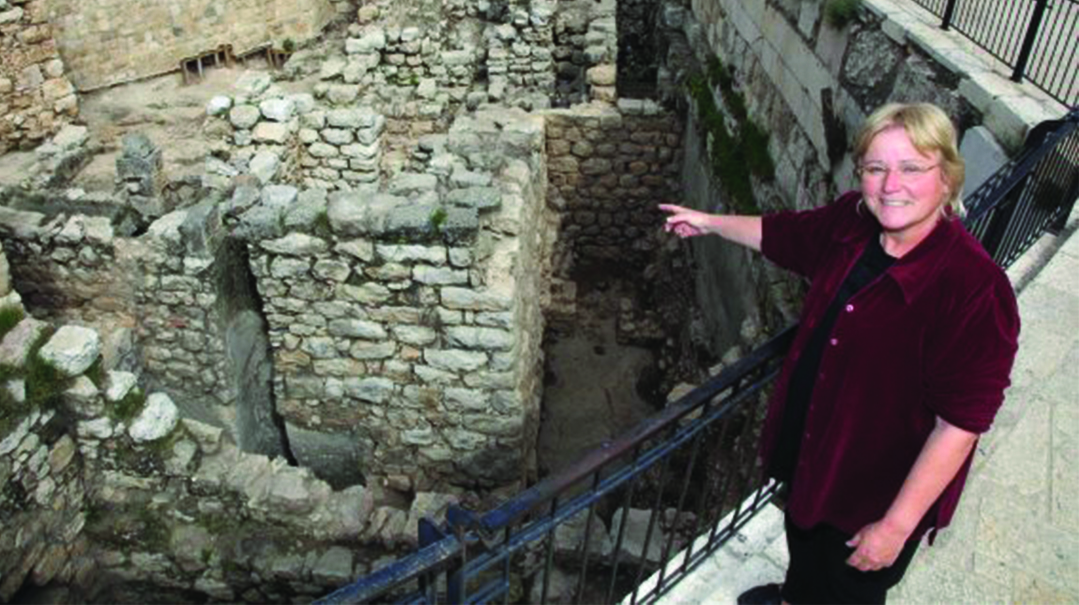
When maverick archaeologist Eilat Mazar a”h passed away last week at age 64 after a prolonged illness, she left behind a legacy that many Jews, even those in Eretz Yisrael, are little aware of: In the face of revisionist history, false narratives, and the debunkers of Jewish claims to Jerusalem, this world authority on Jerusalem’s past fought the good fight to bring Dovid Hamelech and the Beis Hamikdash era out of the pages of Tanach and into living history.
While the Muslim Waqf, the religious authority that administers the Temple Mount, has been propagandizing for years that there was never a Beis Hamikdash on the site (and has been systematically destroying First and Second Beis Hamikdash-era artifacts for decades), it’s not only the Waqf that has cast the shadow of doubt over Judaism’s intrinsic connection to Jerusalem.
Even among Jews, a large number of academics and intellectuals have dismissed the Biblical account of Dovid Hamelech’s kingdom and the ensuing Davidic dynasty as a piece of fiction. This school has also found its voice in Israel’s archaeology arena — a discipline that should be purely scientific but is often politicized. Where the historic layers beneath the ground hold so much potential for present-day conflict, even mainstream archaeologists are inclined to downplay finds that might be considered too highly charged with Biblical or historical accuracy and therefore offend politically correct sensibilities.
While the idea of using the Tanach as a source for historical truth has become increasingly controversial in the halls of Israeli academia, Eilat Mazar would have none of that. With a Tanach in one hand and archaeological tools in the other, she would unapologetically change the narrative.
“The Torah is the most important historical source we have for honest archaeological study, since it contains a genuine and extremely detailed historical account of the past, almost as if it were a blueprint for the future,” she told me when I first met her back in 2005. She had just embarked on the most exciting, if not controversial, project of her career — a quest to unearth King David’s palace on the outskirts of Ir David. And the location was clear to her — against all the naysayers — because she followed the text. “Today the scholarly approach to Tanach is that it’s not true unless you can prove it true. Maybe we should start with the assumption that it’s true?”
While Mazar wasn’t mitzvah observant, Tanach for her was more than just a historical document. It was something to be approached with reverence and awe. Our meeting was in her office, which I remember as being a place of professional clutter: ancient vessels from her excavations of the thousands-year-old Phoenician trading settlement of Achziv on Israel’s northern coast, books on archaeology by both her father and famed grandfather Binyamin Mazar, grids and charts and markings, and her most precious possession — a well-worn, heavily tagged Tanach.
Eilat Mazar was determined and focused, energetic and passionate, but even though she rode a motorcycle and smoked thin cigars, there was a softness about her as well. It was the tenderness that comes with a life of challenges. At the time, she was a young widow of 48, raising four children on her own after her husband, archaeologist Yair Shoham, passed away suddenly of a heart attack at age 44.
While juggling her young family, who would often share her adventures, Mazar was a field archaeologist, a lecturer at the Hebrew University’s Institute of Archaeology in Jerusalem, and head archaeologist for the former Shalem Center’s Institute of Archaeology. Over the years, her discoveries included some of the earliest known artifacts in ancient Jerusalem — scientifically excavated evidence proving the Biblical narrative of a united monarchy that ruled from these parts.
In one discovery, using Tanach as her blueprint, Mazar uncovered a section of the wall that Nechemiah built when he arrived in Jerusalem as governor after the Persian King Darius II permitted the Jews to return to Eretz Yisrael and rebuild the Second Beis Hamikdash. Sefer Nechemiah relates that despite the resistance of hostile locals who’d occupied the area in the Jews’ absence, Nechemiah strengthened the morale of the residents and rebuilt the entire wall around the city in a speedy 52 days. Mazar found remnants of that wall, true to the description of her trusty Tanach.
Mazar also discovered part of the ancient city walls built by Shlomo Hamelech (Melachim 3:1) located between the Har Habayis and Ir David, known as the Ophel, and even found the seal of King Chizkiyahu there — proving again that First Beis Hamikdash-era kings lived right here.
But it was her excavation on the elevation abutting the City of David, down the hill and south of Har Habayis, that shook the archaeological world. For lying undisturbed for nearly 3,000 years was a massive building that Mazar was convinced is King David’s palace.
Look in the Right Place
From the time she was a teenager, Eilat worked closely with her grandfather, renowned archaeologist Binyamin Mazar, who conducted the Southern Wall excavations on the southern continuum of the Western Wall. It was from him that she learned how to honor the Biblical narrative.
“One of the many things I learned from my grandfather was how to relate to the Biblical text,” she said. “Pore over it again and again, for it contains within it descriptions of genuine historical reality. Concealed within the text are the grains of detailed historical truth.”
She earned a doctorate in archaeology from Hebrew University, and in the 1970s and ’80s worked on the digs supervised by Yigal Shiloh in Ir David. The significant discoveries made then, including a huge edifice called the “Stepped-Stone Structure” — which Shiloh believed was either a retaining wall for King David’s royal palace or part of the Jebusite fortress he conquered — ignited Mazar to continue to look for the grand prize: King David’s palace itself.
Some Biblical scholars gave up looking for the palace because, Mazar told me, they were simply looking in the wrong place. These scholars searched for remains of the palace within the walls of the ancient Jebusite city that King David conquered and called Ir David — yet found nothing that could match its description. The historic city of Ir David, while heavily fortified with both natural and man-made boundaries, was also very small, just nine acres in size. So, when no evidence of the majestic palace the Bible describes was found there, it was a short step away from the heretical claim that King David’s monarchy never really existed.
But quite a bit about Dovid Hamelech’s palace is known from Tanach. It was a “house of cedars” built by Chiram, King of Tzor (Tyre), the contemporary Phoenician ruler and his ally against the Pelishtim (II Shmuel, 5:11 and Divrei Hayamim 1, 14:1) who used the cedars of Lebanon and developed a distinct style of stone masonry. And in fact, remains of pillars and decorative stone capitals in this particular style — marks of Phoenician construction, in which Mazar was an expert — were discovered up the hill from Ir David, which was one clue Mazar used in her search for the palace.
“I always suspected that the palace was outside the city,” she said at the time, and cited Tanach to prove it. When the Pelishtim heard that Dovid had been anointed, they went on the attack to apprehend him. This occurred after he conquered the “Metzudas Tzion (Fortress of Zion),” which was the actual nucleus of the Jebusite city, and after he built his palace. The text says that when Dovid went to meet the aggressive Pelishtim, he “descended to the fortress,” (II Shmuel 5:17), implying that he went down from his palace, which was higher up on the mountain than the citadel (the actual city).
“I always asked myself: ‘Down from where?’ It must have been from his palace on top of the hill, outside the fortified but cramped Jebusite city,” Mazar told me.
Mazar said she was confident in her assessment of where the palace would be. And in fact, the structure she discovered — a section of massive wall running about 100 feet from west to east — is built on the summit of hill that bordered the original city.
What most amazed Mazar once she began the dig was how close the building was to the surface — just three to six feet underground. “The cynics kept saying, ‘There will be so many layers, so many remnants of other cultures, it’s not worth digging; it’s too far down.’ I was shocked at how easy it was to uncover it and how well-preserved it was, as if it were just waiting 3,000 years for us to find it,” Mazar told me.
The Bible says that Dovid Hamelech brought the Mishkan to its final home in this original Jerusalem, expanded the city, and made it the spiritual and economic capital of the world at that time.
“The construction that we found was a complicated and intricate engineering operation that must have required immense resources, and the historical dating that we conducted on our findings matches up to the time period of King David,” said Mazar. “This is the kind of step one would expect of a new ruler who wants to turn the city he conquered into his permanent residence, and who has an exceptional vision of the future development of the city.”
No Takers
It seemed so obvious. Yet for more than a decade prior to the dig, Mazar had been proposing her solid thesis as to the location of the palace, based on previous excavational evidence and her own meticulous reading of Tanach — only to encounter skepticism and refusal.
Still, after years of digging in and around Ir David under her professional mentor Yigal Shiloh, and based on finds several decades earlier by British archaeologist Kathleen Kenyon, she knew she was in the right place. In fact, King David’s palace was the topic of her last conversation with her grandfather. Right before he died, he told her, “Kenyon found the proto-Aeolic capitals (of the decorative Phoenician stonework), so go and find where she found them, and start there.”
It was simpler said than done. Despite Mazar’s sound hypothesis and impeccable credentials, she couldn’t find any financial sponsors for the proposed dig. Apparently no one in the academic world really wanted to find Dovid Hamelech’s palace — the ramifications would just be too politically complicated in the Mideast tinderbox of competing historical narratives. It’s no wonder, when even mainstream archaeologists, ever self-conscious about Biblical pursuits, are inclined to play down finds that might be considered too highly charged with Biblical or historical accuracy. (Following the excitement after her find, archaeologist Israel Finkelstein — professor emeritus at Tel Aviv University’s Department of Archaeology who trained a generation of students to believe that the Biblical accounts of Kings David and Shlomo are essentially false, that if they existed at all, they were merely “hill-country chieftains” and Jerusalem a poor, small tribal village — characterized the hype and hoopla over Mazar’s discovery as “messianic eruptions in Biblical archaeology.”)
Mazar’s proposal finally found a sponsor in the Shalem Center, a former Jerusalem research institute (it morphed into Shalem College in 2013) that at the time had established an institute for archaeological studies.
Yoram Hazony, founder of the Shalem Center and today president of the Herzl Institute in Jerusalem, says he first heard Eilat Mazar’s voice on the radio in the early 2000s when she was heading a team of volunteers digging through the dirt and artifacts that the Muslim Waqf was systematically dumping outside the city walls.
At the time, Hazony was the center’s academic head, responsible for recruiting scholars and fellows. He listened as Mazar pleaded with her listeners, distraught over the wanton destruction taking place right under the noses of the Antiquities Authority on the Temple Mount. As a spokesperson for the Committee Against the Desecration of Antiquities on the Temple Mount, she spent the last 20 years of her life alerting the world to the vandalism being perpetrated by the Waqf, but the most glaring breach took place in 2000, during an operation to expand an underground mosque into a massive gathering center for up to 30,000 worshippers.
Workers forged an enormous hole, 40 meters long and 12 meters deep, destroying ancient water systems, smashing walls and pillars, and crushing thousands of years of history into rubble. But where could the Waqf secretly dispose of 10,000 tons of rubble from such a massive project? And, what to do with all the smashed stones and pillars that were obviously linked to the Beis Hamikdah, which the Waqf denies even existed?
Some stones were recut and used as pavement slabs and building stones. Other artifacts were spirited away to Ramallah. As for the rubble, in the dead of night, a hundred truckloads of debris were brough to the municipal dump in East Jerusalem and to the Kidron Valley, where the Temple Mount soil was mixed with modern garbage.
(At the time, an archaeology student named Tzachi Zweig blew the whistle on the Waqf when he and some snooping friends discovered Temple artifacts in junk heaps around Jerusalem. Eventually, under the supervision of his mentor Professor Gabriel Barkay, dozens of truckloads of the “garbage” were moved to a site near Mount Scopus, where until today teams of archaeologists and volunteers continue sifting through the Temple “dirt” to find valuable, significant artifacts from the First and Second Temple periods.)
“I heard her on the radio crying about the destruction of the archaeological layers under Har Habayit, and she was so impassioned and full of love for the Jewish People and Jewish history that I told my colleagues that we had to recruit her,” Hazony remembers. “She told me she’d been in the wilderness as a scholar for the last 15 years, because the entire direction of archaeology in Israel for the last two decades was predicated on the idea that the Torah was a big lie. She had such a simple and beautiful belief in the Tanach as a guide to uncovering our history, but she couldn’t get funding because the professionals in the field were either committed to the notion that there was no such thing as King David’s palace, or they were in the closet hiding their views.”
Hazony and his team wanted to help her, and so they spent the next year studying her thesis, with input from the Antiquities Authority and archaeologists from the different camps.
“Their basic line was that Ir David had been excavated for decades and they’d never found Dovid Hamelech’s palace yet, so the likelihood of finding it was extremely low. But we did our homework and discovered that Eilat was really on solid ground. We decided that we had to help her find the palace and overturn the entire mindset of the archaeological narrative of what Jerusalem was at the time.”
One of the center’s supporters, an American Jewish investment banker named Roger Hertog, agreed to put up a million dollars for the dig. He told the New York Times that he fronted the dig because he wanted to encourage scientific support for the Bible as a reflection of Jewish history.
Just three weeks into the dig, Mazar hit walls 20 feet thick where no one else thought anything could be found.
“The effect was absolutely electrifying,” says Hazony, “because from that moment, for the archaeologists who had been in the closet saying maybe Tanach is true but were too scared to speak out, the whole debate started shifting. I wouldn’t say we won the debate — there are still many archaeologists who won’t concede to the veracity of Tanach, but this was the turning point, the point of inflection where it became possible for some of them to consider the possibility that true to the Biblical narrative, there actually was a powerful, unifying Davidic dynasty.”
Sealed for Eternity
Mazar always made it clear that she was a researcher and not some sort of divine emissary revealing the eternity of King David’s kingdom. “I am a scientist, not a philosopher,” she said. But she qualified, “Still, I am a Jew and an Israeli, and I feel great joy when the details on the ground match the descriptions in the Bible. Today it’s become fashionable to say there was no David, no Solomon, no Temple, no prophets. But suddenly the facts on the ground are speaking, and those outspoken voices of opposition are stammering.”
And those facts on the ground were more than just the remains of a building. She discovered an array of vessels and artifacts that not only indicated the palace was used by King David, but that it remained a home for Jewish monarchs until the destruction of the First Beis Hamikdash 450 years later.
Just before the digging season ended at the onset of the rains, she came into Hazony’s office one morning crying. She told him she’d been up all night deciphering something she’d found called a “bullah” — a clay disc inscribed in ancient Hebrew script, used to seal papyrus scroll “mail,” with the name of the sender as a “return address.”
After finding the bullah the previous day, Mazar had taken it home to examine and decipher. Her late husband, Yair Shoham, was both an archaeologist and epigraphist, and one of the things he unwittingly left his young family was a table of letters — a key to the ancient script in order to study and date bullahs. With the help of a needle and magnifying glass, she cleaned off the grains of dust and unveiled the ancient inscription. Then she showed her boys, aged 14, 13, and 11, how to use their father’s table of letters to decipher the writing on the clay disc. And there it was: the name “Yehuchal ben Shelemiah.”
Mazar knew the name “Yehuchal” sounded familiar but couldn’t quite place it. Then she opened up Sefer Yirmiyahu and found his name mentioned as one of two emissaries dispatched by King Tzidkiyahu to the prophet Yirmiyahu, asking him to pray for the people during the siege of Jerusalem by Nebuchadnezzar, King of Babylon. In an about-face, Chapter 38 relates that Yehuchal was one of four ministers who asked the king to kill Yirmiyahu, claiming that he was demoralizing the besieged nation with his prophecies of doom and destruction.
The bullah found on the site of the palace — Yehuchal’s “business card” — indicates that the building Mazar had unearthed against so many odds was indeed still used by the king, or at least by his ministers, until the destruction of Jerusalem soon afterward.
“For me, finding the bullah was tremendous,” Mazar told me. “Yehuchal was no longer just some name in a Biblical account. He was a real person. The account is a real account. It is very rare to find such precise evidence for a narrative in the Tanach.”
Hazony, who says he’s devastated by Mazar’s passing, believes that when the dust clears in the field of Israeli archaeology, “we’re going to look back and say, at the moment that Eilat hit that 20-foot-thick wall, that was the moment it all turned. Because of her passion for the honor of Tanach and extraordinary belief that the Tanach was true, she switched the narrative — that it’s simply impossible that Tanach was lying to us all these years.”
IS IT “TOO JEWISH”?
While Eilat Mazar was looking for a sponsor for her dig — firm in the knowledge that her hunch about where Dovid Hamelch’s palace really lay was right — she said at the time that she felt like a kindred spirit with Adam Zertal, an archaeologist who passed away in 2015 and faced a similarly hostile environment. Zertal, who was severely wounded in the 1973 Yom Kippur War and used crutches on his excursions, once told a reporter for the Jerusalem Post, “I spent a year at Hadassah Hospital in Jerusalem, and I became interested in archaeology. Although I had argued that the Bible was full of myths, I decided after my recovery to travel the land by foot to look for archeological evidence.” And he found it. In 1983, Zertal discovered an enormous sacrificial altar on Har Eval, on the very mountain where Yehushua, as described in Sefer Yehoshua, built an altar after the Jews crossed the Jordan River. The altar he found contained tools dating to the 12th century BCE, the time the Jewish people entered the Land, and its construction matched the descriptions of Yehoshua’s altar in both biblical and rabbinic texts. But instead of the expected excitement accompanying such a monumental find, Zertal’s academic colleagues ignored him and his discovery. Some of his detractors accused Zertal, a secular Jew raised on a kibbutz, of being politically motivated to support Jewish settlements in the area around Shechem, where Har Eval is located. After all, Har Eval is the twin mountain of Har Gerizim, and the city of Shechem (what the Arabs call “Nablus” — the nucleus of violent Palestinian nationalism) is right between the two. Legitimizing the discovery would just make Shechem “too Jewish.” Mazar, too, knew that it was bad for business to find things from the Bible, but she forged on nonetheless.
(Originally featured in Mishpacha, Issue 863)
Oops! We could not locate your form.
